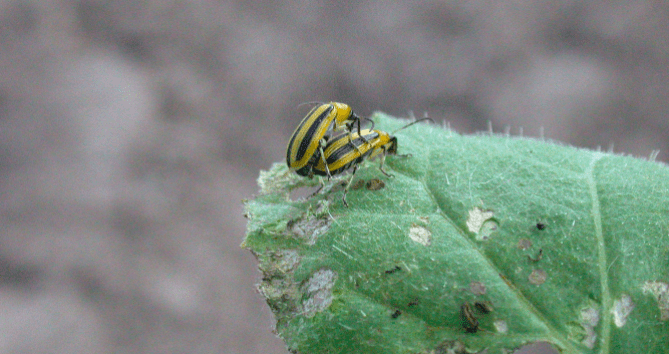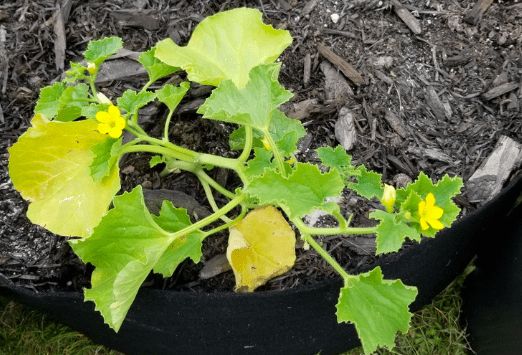If you are a cantaloupe farmer, or just happen to have a few cantaloupes growing in your garden, you may be wondering why the leaves are turning yellow. Don’t worry, you’re not alone!
This is a question that many people have about this fruit. In this blog post, we will explore the possible causes of this phenomenon and provide some solutions.
Why Are My Cantaloupe Leaves Turning Yellow?
Your cantaloupe leaves are turning yellow because they have been given too much water, not enough sunlight, are suffering from a nutrient deficiency, or have been attacked by pests.
It’s important to figure out which one of these is the problem so that you can take the appropriate action. I will now go into more detail about each of these causes.
Yellow Cantaloupe from Overwatering
Like with any plant, too much water can be detrimental to a cantaloupe plant. If the leaves are yellow and wilting, this is a sure sign that the plant is getting too much water.
The best way to know if your plant is getting too much water is to check the soil. If it is soggy or mushy, the plant has been given too much water. If the soil is dry, then the plant needs more water.
To fix this problem, you need to either reduce the amount of water you are giving the plant or increase the drainage in the area where it is growing. If you have a cantaloupe that is growing in a pot, make sure to empty out the saucer beneath it after.
If your cantaloupe is growing in the ground, ensure the area has good drainage. You may need to add some gravel or sand to the soil to improve drainage.
Yellow Cantaloupe from Pests
Finally, another reason why your cantaloupe leaves may be turning yellow is because of pests. Insects such as aphids, whiteflies, and squash bugs can suck the sap out of the leaves, causing them to turn yellow.
When these pests suck the sap from the leaves, they leave behind a sticky substance called honeydew. This substance can attract other pests, such as ants and wasps.
This honeydew also blocks photosynthesis from occurring, further stressing the plant and causing the leaves to turn yellow in the process.
To get rid of these pests, you can use insecticidal soap or neem oil. You can also try to attract natural predators, such as ladybugs and lacewings.
I like using this neem oil as it is an all-natural way to get rid of pests. Neem oil is made from the seeds of the neem tree and it works by disrupting the life cycle of insects.
Apply it to the leaves of your plant, making sure to get the undersides of the leaves as well. You will need to reapply it every few days for it to be effective.

Yellow Cantaloupe from Lack of Sunlight
All plants need sunlight to grow and produce fruit. Cantaloupes are no different. If the leaves of your plant are turning yellow, it could be because it is not getting enough sunlight.
Chlorophyll, which is responsible for the green color in plants, is produced through a process called photosynthesis. This process needs sunlight to occur.
If your plant is not getting enough sunlight, it will not be able to produce chlorophyll and the leaves will turn yellow. The best way to fix this problem is to move the plant to an area where it will get more sunlight.
Yellow Cantaloupe from Manganese Toxicity
Manganese is an essential nutrient for plants. It helps with the production of chlorophyll and the development of strong roots. However, too much manganese can be toxic to plants.
Manganese thrives in soil with a pH below 5.4, so the best way to fix this problem is to test the pH of your soil and adjust it accordingly. You can do this by adding lime to raise the pH or sulfur to lower it.
There’s also a good chance not there aren’t enough nutrients in the soil to support the growth of your cantaloupe plant. This is especially true if the leaves are young and just starting to turn yellow.
The best way to fix this problem is to fertilize the plant with a high-quality fertilizer that contains all of the essential nutrients for plants, especially nitrogen.

Yellow Cantaloupe Leaves FAQs
I will now discuss some of the most frequently asked questions when it comes to yellowing leaves on a cantaloupe…
Should I cut yellow leaves off my cantaloupe?
If the leaves are yellow, they are not doing anything to benefit the plant. In fact, they may even be causing harm. By removing them, you are giving the plant a chance to focus its energy on more productive leaves.
My cantaloupe leaves are yellow and wilting. Is this a problem?
Yes, this is definitely a problem. Wilting leaves are usually a sign of too much or too little water. Check the soil to see if it is soggy or dry. Adjust your watering accordingly.
Why are the tips of my cantaloupe leaves turning yellow?
This is most likely due to a lack of nutrients. The best way to fix this problem is to fertilize your plant with an all-purpose fertilizer. Check the pH of your soil to check if the yellowing is not due to manganese toxicity or deficiency.
Will the yellow leaves spread to other plants?
Only if the cause is a viral or bacterial infection. If the yellowing is due to a nutrient deficiency, pests, or lack of sunlight, it will not spread to other plants. However, there’s a good chance you will see other plants get yellow leaves if they’re treated to the same way.
Does the type of water matter?
It’s always best to give your plants filtered water. This will help to remove any impurities that may be in the water. If you can’t filter the water, let it sit out for a day or two so that the chlorine can evaporate.
Conclusion
In conclusion, there are several reasons why your cantaloupe leaves may be turning yellow. The most common reasons are lack of sunlight, nutrient deficiencies, pests, and viral or bacterial infections.
The main thing you need to do is figure out what is causing the problem. Once you know that, you can take the necessary steps to fix it, whether that’s adjusting your watering, fertilizing, or using neem oil.
I hope this article was helpful in diagnosing the problem. If you have any other questions, feel free to leave a comment below and I will get back to you as soon as possible. Thanks for reading!
Tim is an avid gardener from the UK. He was the founder of PlantCarer.com from 2021 to Sep 2023. He sold PlantCarer.com to Aaron. He has since started his own business called Seed To Supper, which provides new gardeners all the materials you need in a box (pots, seeds, compost and instructions) to grow your own delicious and nutritious vegetables and herbs from start to finish – no garden required.









0 Comments